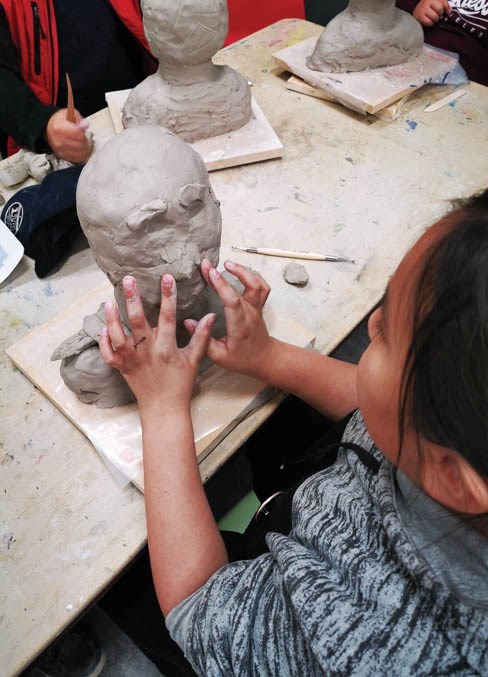EXSHAW – Two educators working with students at Exshaw School have been nominated for the 2019 Governor General’s History Award for Excellence in Teaching after an innovative project engaged an entire community.
Kayla Dallyn and Genevieve Soler from the Canadian Rockies Public School Board (CRPS) have been named finalists for the award after working on a project that involved students looking deeper into their own family histories, with the school project becoming an entire community endeavour for Stoney Nakoda students.
Inspired by an exhibit at Banff's Whyte Museum of the Canadian Rockies, Dallyn and Soler had students work with elders and community members to research a hero from their pasts. The students eventually sculpted their heroes and the works of art they created were featured at artsPlace in Canmore as an exhibit for National Indigenous Peoples Day.
“The kids worked with elders and they researched their own heritage and their own family trees,” said Dallyn.
“They learned about themselves and then they chose a hero from their own family and they worked with [artist] Christine [Wignall] to sculpt them at artsPlace.”
Soler said part of her job is to help support teachers in “Indigen-izing their classrooms” and their curriculum, which is why this project piqued her interest.
“Ninety-nine per cent of our students are Nakoda Nation members, so it’s really important that kids see themselves in school," she said. "That’s kind of my job, so when Kayla talked to me about this project we started thinking of this idea of heroes and people that will inspire kids and motivate kids to be the best people they can be.
“Before we even started working with the kids, we had a conversation with some elders … There’s a big saying in education – ‘nothing about us, without us’ – so if we were going to start this project with students, it was really important to have a conversation with the elders.”
In fact, Soler and Dallyn said the elders came up with the idea that students research their own families, rather than a name they recognize within their community.
“We approached the elders and asked who are your heroes? Who should we be making sure students know about? We didn’t realize how important it was that the heroes they were learning about were from their own families and the elders really helped us see that, it made our project so much more meaningful,” said Dallyn.
The project began with a deep dive into ancestry and created a massive family tree of sorts.
“Before any of the sculpting or research happened, there was this big family tree project that happened at school, which was really beautiful, so we engaged probably 16 elders,” said Soler.
The two educators said the project acted as a “magnet,” with many people from the Stoney Nakoda First Nation becoming intrigued and offering up their own stories as contributions.
“I think the idea of the sculptures themselves would have been a wonderful project, but then it just got deeper and deeper every week when we started speaking with more people and engaging archives, pictures, and different historical stories,” said Soler.
“A lot of the time, information about these heroes weren’t in any library, or weren’t in any archives. They could only be found in the stories of the people. It started this whole new process of bringing kids and elders together to listen to stories and to listen to history first hand. It was just really beautiful to be apart of.”
For Dallyn and Soler, while the nomination is an absolute honour, it’s the many hands and hearts that contributed to the project that made it meaningful.
“It just became this true collaborative project of everyone learning together, just being so inspired together,” said Soler.
“We looked into the curriculum and found outcomes that aligned with it and really made sure it was a curriculum-based project that was meaningful, real-world authentic learning connected to the community,” added Dallyn.
“It is a real honour to be nominated for an award like this. There’s no way this project could have happened without all the collaborators – the elders, the students, artsPlace, Christine Wignall giving us all her time, Amy.”
The Governor General’s History Awards for Excellence in Teaching awards six teachers for “innovative approaches to teaching,” according to the Canada History website. Winners receive a cash prize of $2,500 plus $1000 for their school, as well as an all-expenses paid trip for two to Ottawa to receive the award. The winners are typically announced in late fall.
For more information visit www.canadashistory.ca.




